Navy Nurses during World
War II
.
Outbreak of War
.
When Pearl Harbor in Oahu (Hawaii) was attacked
by the Japanese Imperial Navy on the morning of 7 December 1941, approximately
100 ships of the U.S. Navy were present. Battleships, destroyers, cruisers,
various support ships and one hospital ship, the USS Solace, were
sitting at anchor.
.
The attack was intended to weaken the U.S.
Pacific fleet decisively as well as its defending Army Air Corps and Marine
air forces.
.
Eighteen ships were sunk, including five battleships.
A total of 188 aircraft were destroyed and 155 damaged. The surprise attack
killed 2,403 American soldiers and 68 civilians. In addition, 1,178 military
and civilians were wounded. (Most
of the civilian damage was caused by falling US Navy antiaircraft shells.
These failed to detonate in the air because the shell fuses were not set
correctly.)
.
Within the next six months, the U.S. Navy
was impaired in its role in the Pacific war, due to the devastating losses
at Pearl Harbor. |
.. |

Sailors in a motor launch trying
to rescue a survivor from the water alongside the sunken battleship USS
West
Virginia (BB-48) |
.
 The sunken battleship USS Arizona
(BB-39)
burning furiously
The sunken battleship USS Arizona
(BB-39)
burning furiously
|
.. |
Forty-four members of the Navy Nurse Corps
were stationed at the hospital and dispensary at Pearl Harbor during the
attack. Thirteen of these nurses served aboard the Navy hospital ship USS
Solace. The Navy Nurses faced the horror of war from its first day. Together
with the rest of the Naval medical personnel, they treated the incoming
casualties with self-sacrificing devotion and most efficiently, without
rest for several days. Due to their successful care, many lives were saved. |
.
The 17 other Navy Nurses stationed in the
Pacific area faced enemy attacks shortly afterwards. Twelve Navy Nurses
were assigned to the U.S. Naval Hospital at Canacao, (Philippine Islands)
and 5 Nurses to the U.S. Naval Hospital at Agana on Guam (Marianas Islands).
The Japanese attacked these islands on 10 December 1941. While the 5 nurses
in Guam were taken prisoners of war (POW), the nurses from Canacao were
evacuated before the enemy invasion (but all, except one, were captured
a few weeks later in Manila).
.
When America entered World War II in December
1941, the Navy Nurse Corps awaited an important, difficult and sometimes
dangerous task that needed highly skilled, dutiful and courageous nurses.
Navy Nurses would be deployed at Naval hospitals inside the continental
limits of the USA as well as overseas. Others would join the fleet in hospital
ships.
.
Strength
.
Over 800 Navy Nurses on active duty were serving
in the Navy Nurse Corps at the time of the Pearl Harbor attack. The inactive
Reserve Corps numbered over 900 nurses. After Pearl Harbor, many nurses
followed the urgent call for more graduated nurses in the armed forces
and enlisted either in the Army Nurse Corps or the Navy Nurse Corps. Within
1942, the Navy Nurse Corps had increased to over 2,900 nurses. Over
1,100 of them were serving in the Regular Nurse Corps. More than 1,700
belonged to the Naval Reserve Corps.
.
Nevertheless, in 1943, there still was a desperate
need for nurses in the military. The successful work of the American Red
Cross was important for the armed forces because it was acting as reserve
agency for the Army and the Navy Nurse Corps. Captain Sue S. Dauser, Superintendent
of the Navy Nurse Corps, was especially worried because in her opinion
the Red Cross overemphasized the need of Army Nurses at the expense of
the Navy recruitment.
.
(But probably there were other
reasons why many nurses preferred to serve in the Army Nurse Corps. For
example, the Army Nurse Corps already had allowed the appointment of married
nurses under the age of 40, in October 1942, while Navy Nurses had to be
singles. If a Navy Nurse wanted to get married, she had to resign. To permit
marriage was definitely a change in the Army regulations that made the
Army Nurse Corps more attractive for many women.) |
.. |
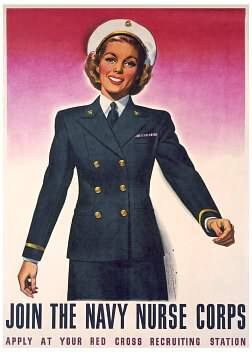 |
.
However, during 1943, the highest number of
new recruits was appointed to the Navy Nurse Corps. With over 4,000 additional
nurses the total strength topped the mark of 7000.
.
 Young nurse applies for the
Navy Nurse Corps.
Young nurse applies for the
Navy Nurse Corps.
|
.. |
Hoping to improve the recruitment success,
the Navy Nurse Corps took over the processing of applications in the end
of 1943. Furthermore, the Red Cross always continued to inform all nurse
applicants about both military branches and more than half of all new recruits
were still referred by the Red Cross. The number of Navy Nurses continued
to grow in the next year, but the rise was less than 1,900 members. At
the end of 1944, the Nurse Corps numbered 8,893 personnel. Nearly
7,000 of them were Reserve Nurses on active duty. |
.
| In early 1945, there was an urgent need of
nurses again. The American military originally projected the number of
required nurses based on overly optimistic forecasts that Germany and Japan
would be defeated in 1945 without heavy casualties.
However, the Germans launched their strong
Ardennes counteroffensive of December 1944 in Europe and unexpectedly fierce
Japanese resistance reached new heights in the Pacific.
Therefore, suddenly the War Department realized
they would need massive new amounts of nurses -- especially if the terribly
costly invasion of Japan would take place in late 1945 or early 1946 (which
was only avoided by nuclear bombs). |
.v |
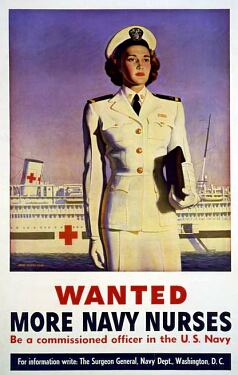 |
.

President Franklin
Delano Roosevelt
|
... |
In January 1945, President Roosevelt sent
a message to the Congress concerning this problem. He requested the draft
of nurses into the armed forces because the volunteering had not been sufficient
enough.
The draft bill was put down after a few weeks
of discussion. Instead, other efforts were made to raise the number of
volunteers. |
..
Another factor was that the War Department
opened the service in the armed forces for Black nurses, ending all former
quotas and exclusion. There were about 9,000 graduated Black nurses in
the United States at that time. 308 of these Black nurses already served
in the Army Nurse Corps that had permitted Black nurses to join the Army
Nurse Corps in in 1941 (but in limited numbers only).
.
| The Navy Nurse Corps had not accepted any
Black nurses so far. The first Black nurse in the Navy Nurse Corps started
her active duty in April 1945.
Until January 1948, none of the Black nurses
was a member of the Regular Corps. All of them had been members of the
Reserve Nurse Corps .
All together, the Navy Nurse Corps appointed
5 Black nurses during World War II. Obviously, it was not a real breakthrough. |
.v |
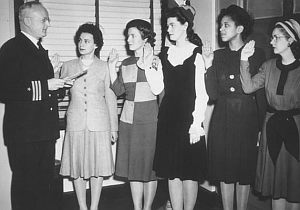 The Navy's first African-American
nurse, Phyllis Mae Dailey (second from the right). is taking oath
of office together with four outher nurses administered by Cmdr. Thomas
A. Gaylord, USN
The Navy's first African-American
nurse, Phyllis Mae Dailey (second from the right). is taking oath
of office together with four outher nurses administered by Cmdr. Thomas
A. Gaylord, USN
|
.
The Navy Nurse Corps put much more efforts
to trying to stop the high losses of members due to marriage. In 1944 an
average of more than 100 nurses a month resigned by reason of marriage
(the high point being 160 resignations in November 1944). In January 1945,
a change in the regulation permitted Navy Nurses in service to marry without
being required to resign. In February, former members of the Navy Nurse
Corps and Naval Reserve Nurse Corps were permitted temporary reappointment,
if they had resigned because of marriage between January 1944 and January
1945. Only women who were already married before they wanted to join, were
still barred from entering the service.
After the end of war, no large Nurse Corps
was needed anymore. Therefore, in September 1945, the relaxed regulations
considering marriage were rescinded. Additionally, a month later an official
announcement declared that effective 1 November 1945 all married officers
of the regular and the reserve corps who were temporarily reappointed would
be released. This way the Nurse Corps conveniently disposed a part of the
excess nurses without granting them the usual 6 months provision after
the end of war.
.
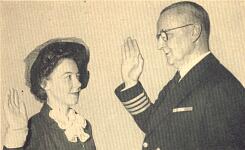 A Navy Nurse applicant is taking
oath of office.
A Navy Nurse applicant is taking
oath of office.
|
.. |
The Navy Nurse Corps reached its peak strength
in June 1945 with over 11,000 members on active duty. Only 1,800 of them
served in the Regular Corps. The big majority of more than 9,000 nurses
belonged to the Reserve Nurse Corps. |
.
In April 1945, the Navy discontinued active
recruiting of nurses. Surplus applicants were referred to the Army Nurse
Corps. The decision to stop recruitment of nurses could have caught the
Navy severely shorthanded with nurse personnel in the following months.
In fact, the Navy casualties soared in 1945 with the sanguinary fleet losses
off Okinawa. A catastrophe in the low number of nurses was only avoided
by the quick surrender of Japan following the atomic bombings. The nuclear
destruction of Japanese cities (an Air Force mission unforeseen by the
Navy) and the unexpected surrender in September spared the Navy a major
embarrassment for lack of proper planning ahead.
A total of 40 Navy Nurses died in service,
but no death was a result of enemy action.
After the war, a huge demobilization started.
Within a year, the membership had been reduced to about 2,300 nurses (nearly
1,250 of them serving in the Regular Navy). The government offered help
to bring back all the veterans, including the women who served in the armed
forces, to Civilian Service. For example, a money allowances was granted
through the G.I. Bill of Rights for unemployed or partially employed veterans.
However, the situation for nurses to find a job after leaving the service
was much better than for many other professions. The enormous numbers of
disabled and wounded soldiers requiring long-term (some required years
or decades of intensive medical treatment) and short-term care, following
the war, required more nurses than were available and made jobs for any
returning from the service.
.
| Year... |
Numbers |
| 1941 |
823 |
| 1942 |
2,907 |
| 1943 |
7,022 |
| 1944 |
8,893 |
| 1945 |
11,025 |
| 1946 |
9,077 |
| 1947 |
2,263 |
.
(The numbers were derived from
Annual Report Navy
and Marine Corps Military Personnel
Statistics, 30 June 1959.
The highest personnel strength
for the year is listed.)
.
Officer Status
.
When America entered World War II, the Navy
Nurses had been granted neither the status of Naval officers nor the rating
of enlisted personnel. Only Army Nurses had received the relative rank
of officers in 1920. Eventually, the Congress reconciled this inequality
and authorized permanent relative rank for Navy Nurses as well, on 3 July
1942. The Navy Nurse Corps received relative rank from ensign to lieutenant
commander.
.
Captain Sue S. Dauser (NC)
USN, photographed at the Navy Department, circa 1944.
.
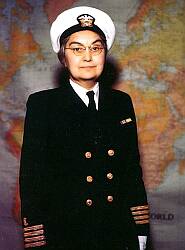
.
Ms. Dauser was the first women
to wear the captainís four golden stripes on her sleeves.
|
.. |
On 22 December 1942, Congress passed a law
authorizing temporary relative rank from Captain to Ensign and a higher
temporary pay scale for Nurse Corps personnel for the war period plus 6
months. These were further concessions to the vital job nurses did during
this war. Of course, the improvements were intended to attract more nurses
to apply. Two assistant superintendents in the rank of commander, and 4
directors in the rank of lieutenant commanders were appointed to the Navy
Nurse Corps.
.
On 26 February 1944 the Army and Navy Nurses
were given actual military rank, approved for the duration of the war plus
6 months. Sue S. Dauser was appointed the first female captain in the U.S.
Navy. Finally in April 1947, the Navy Nurse Corps received permanent commissioned
status and the corps was integrated in the medical Department. |
.
.
|
